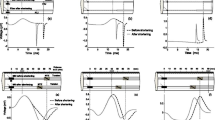Abstract
This paper presents a bioelectrochemical model for the activation of action potentials on sarcolemma and variation of Ca2+ concentration in sarcomeres of skeletal muscle fibers. The control mechanism of muscle contraction generated by collective motion of molecular motors is elucidated from the perspective of variable-frequency regulation, and action potential with variable frequency is proposed as the control signal to directly regulate Ca2+ concentration and indirectly control isometric tension. Furthermore, the transfer function between stimulation frequency and Ca2+ concentration is deduced, and the frequency domain properties of muscle contraction are analyzed. Moreover the conception of “electro-muscular time constant” is defined to denote the minimum delay time from electric stimulation to muscle contraction. Finally, the experimental research aiming at the relation between tension and stimulation frequency of action potential is implemented to verify the proposed variable-frequency control mechanism, whose effectiveness is proved by good consistence between experimental and theoretical results.
Similar content being viewed by others
References
Hill A V. The heat of shortening and the dynamic constants of muscle. Proc R Soc Lond B, 1938, 126: 136–195
Gordon A M, Huxley A F, Julian F J. The variation in isometric tension with sarcomere length in vertebrate muscle fibres. J Physiol, 1966, 184: 170–192
Ai B Q, Wang X J, Liu G T, et al. Dynamic model for muscle’s motion (in Chinese). ACTA Sci Nat Univ Sunyatseni, 2001, 40(6): 27–30
Telley I A, Denoth J, Stussi E, et al. Half-sarcomere dynamics in myofibrils during activation and relaxation studied by tracking fluorescent markers. Biophys J, 2006, 90: 514–530
Yin Y H, Guo Z. Collective mechanism of molecular motors and a dynamic mechanical model for sarcomere. Sci China Tech Sci, 2011, 54(8): 2130–2137
Huxley H E. The mechanism of muscular contraction. Science, 1969, 164: 1356–1366
Huxley A F. Muscular contraction. J Physiol, 1974, 243: 1–43
Huxley A F, Simmons R M. Proposed mechanism of force generation in striated muscle. Nature, 1971, 233: 533–538
Spudich J A. How molecular motors work. Nature, 1994, 372: 515–518
Anthony L F, Erickson H P, Rousseau E, et al. Purification and reconstitution of the calcium release channel from skeletal muscle. Nature, 1988, 331: 315–319
Cannel M B, Allen D G. Model of calcium movements during activation in the sarcomere of frog skeletal muscle. Biophys J, 1984, 45: 913–925
Stuyvers B D, McCulloch A D, Guo J Q, et al. Effect of simulation rate, sarcomere length and Ca2+ on force generation by mouse cardiac muscle. J Physiol, 2002, 544, 3: 817–830
Guo Z, Yin Y H. A dynamic model of skeletal muscle based on col-lective behavior of myosin motors-Biomechanics of skeletal muscle based on working mechanism of myosin motors (I). Sci China Tech Sci, 2012, 55
Jayasinghe I D, Cannell M B, Soeller C. Organization of ryanodine receptors, transverse tubules, and sodium-calcium exchanger in rat myocytes. Biophys J, 2009, 97(10): 2664–2673
Tanabe T, Takeshima H, Mikami A, et al. Primary structure of the receptor for calcium channel blockers from skeletal muscle. Nature, 1987, 328: 313–318
Takeshima H, Nishimura S, Matsumoto T, et al. Primary structure and expression from complementary DNA of skeletal muscle ryanodine receptor. Nature, 1989, 339: 439–445
Toyoshima C, Nakasako M, Nomura H, et al. Crystal structure of the calcium pump of sarcoplasmic reticulum at 2.6 Å resolution. Nature, 2000, 405: 647–655
Fortune E, Lowery M M. Effect of extracellular potassium accumulation on muscle fiber conduction velocity: A simulation study. Ann Biomed Eng, 2009, 37(10): 2105–2117
Piitulainen H, Botter A, Merletti R, et al. Muscle fiber conduction velocity is more affected after eccentric than concentric exercise. Euro J App Physiol, 2010, 111(2): 261–273
Maxwell M H, Kleeman C R. Clinical Disorders of Fluid and Electrolyte Metabolism. New York: McGraw-Hill Companies, 1968. 28
Endo M. Calcium-induced calcium release in skeletal muscle. Physiol Rev, 2009, 89: 1153–1176
Escobar A L, Monck J R, Fernandez J M, et al. Localization of the site of Ca2+ release at the level of a single sarcomere in skeletal muscle fibres. Nature, 1994, 367: 739–741
Dux L, Martonosi A. Two-dimensional arrays of proteins in sarcoplasmic reticulum and purified Ca2+-ATPase vesicles treated with vanadate. J Biol Chem, 1983, 258: 2599–2603
Levitan I B, Kaczmarek L K. The Neuron Cell and Molecular Biology. 2nd ed. New York: Oxford University Press Inc, 1997. 37–39
Allen D C, Arunachalam R, Mills K R. Critical illness myopathy: Further evidence from muscle-fiber excitability studies of an acquired channelopathy. Muscle Nerve, 2008, 37: 14–22
Baylor S M, Hollingworth S. Calcium indicators and calcium signalling in skeletal muscle fibres during excitation-contraction coupling. Prog Biophys Mol Biol, 2011, 105: 162–179
Kreutziger K L, Piroddi N, Scellini B, et al. Thin filament Ca2+ binding properties and regulatory unit interactions alter kinetics of tension development and relaxation in rabbit skeletal muscle. J Physiol, 2008, 586, 15: 3683–3700
MacIntosh B R, Gardiner P F, McComas A J. Skeletal Muscle: Form and Function. 4th ed. Xi’an: Fourth Millitary Medical University Press, 2010. 4–5
Chen Z R. Clinical application of electromyography (EMG). J Mod Electrophysiol, 2005, 12(1): 42–46
Wang F, Luo Z Z. Based on the power-spectrum to classify the pattern of the surface electromyography. J Hangzhou Inst Electr Eng, 2005, 25(2): 37–40
Pasquet B, Carpentier A, Duchateau J, et al. Muscle fatigue during concentric and eccentric contractions. Muscle Nerve, 2000, 23: 1727–1735
Edwards R H T, Hill D K, Jones D A, et al. Fatigue of long duration in human skeletal muscle after exercise. J Physiol, 1977, 272: 769–778
Kesar T, Chou L W, Binder-Macleod S A. Effects of stimulation frequency versus pulse duration modulation on muscle fatigue. J Electromyogr Kinesiol, 2008, 18(4): 662–67
Author information
Authors and Affiliations
Corresponding author
Rights and permissions
About this article
Cite this article
Yin, Y., Chen, X. Bioelectrochemical control mechanism with variable-frequency regulation for skeletal muscle contraction—Biomechanics of skeletal muscle based on the working mechanism of myosin motors (II). Sci. China Technol. Sci. 55, 2115–2125 (2012). https://doi.org/10.1007/s11431-012-4777-x
Received:
Accepted:
Published:
Issue Date:
DOI: https://doi.org/10.1007/s11431-012-4777-x




